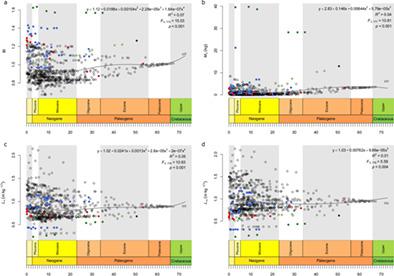当前位置:
X-MOL 学术
›
J. Morphol.
›
论文详情
Our official English website, www.x-mol.net, welcomes your
feedback! (Note: you will need to create a separate account there.)
The link between avian brachial index, flight capability and the neornithine evolutionary radiation
Journal of Morphology ( IF 1.5 ) Pub Date : 2021-09-27 , DOI: 10.1002/jmor.21414 Carolina Karoullas 1 , Robert L Nudds 1
Journal of Morphology ( IF 1.5 ) Pub Date : 2021-09-27 , DOI: 10.1002/jmor.21414 Carolina Karoullas 1 , Robert L Nudds 1
Affiliation

|
In dictating the relative distances between the elbow, shoulder and wrist, avian brachial index (BI = humerus/radius-ulna length) likely influences wing kinematics and, therefore, might predict extinct avian flight capability. This underpins the hypothesis that non-neornithine Mesozoic avialans with relatively low BIs (associated with improved flight capabilities) restricted neornithine diversification until after the Cretaceous–Paleogene boundary. Here, correlations between flight metrics (wingbeat frequency (f), stroke angle (θ), wing loading (Q) and aspect ratio) and BI were investigated and vice versa. Additionally, the evolutionary model best describing the phylogenetic distribution of BI, and the temporal patterns in BI, flight metrics, body mass (Mb), and size-corrected humerus (Lh) and radius-ulna (Lru) length were determined. BI was best described by Ornstein–Uhlenbeck processes, with low α values indicating a gradual shift towards a future theoretical optimum. BI also decreased overall through evolutionary time with the flight metrics mirroring temporal patterns of change in BI. Mb, Lh and Lru overall decreased apart from increases in Lh and Lru following the middle-late Miocene (also leading to BI increasing) due to diversifications of the Anatinae and Sphenisciformes. Lh overall decreased further than Lru. Consequently, decreasing Lh mainly contributed to decreasing BI through evolutionary time, implying flight performance increased through neornithine evolution. However, the timings of radiations in these variables implies an Eocene radiation of neornthine flight ecology rather than a rapid expansion into niches vacated by non-neornithine Mesozoic avialians following the Cretaceous–Paleogene boundary. Multiple regressions showed f, θ and Q explained 60% of variation in BI. However, unequivocally evaluating whether BI is related to wing movement (and flight capability) requires direct measures of wing movement for many species, which are currently unavailable. Finally, the findings here and previously observed clade-specificity in BI, suggest flight ecology may also be clade-specific. Hence, the utility of phylogeny in predicting flight ecology requires exploration.
中文翻译:

鸟类肱骨指数、飞行能力和新鸟进化辐射之间的联系
在决定肘部、肩部和腕部之间的相对距离时,鸟类肱骨指数(BI = 肱骨/桡骨-尺骨长度)可能会影响机翼运动学,因此可能预测灭绝的鸟类飞行能力。这支持了以下假设,即具有相对较低 BI(与改进的飞行能力相关)的非新鸟类中生代鸟类限制了新鸟类的多样化,直到白垩纪 - 古近纪边界之后。在这里,研究了飞行指标(翼拍频率(f)、行程角(θ)、翼载荷(Q)和纵横比)和 BI 之间的相关性,反之亦然。此外,进化模型最好地描述了 BI 的系统发育分布,以及 BI 的时间模式、飞行指标、体重(M b ),并确定了尺寸校正的肱骨 ( L h ) 和桡尺骨 ( L ru ) 长度。Ornstein-Uhlenbeck 过程最好地描述了 BI,低α值表明逐渐转向未来的理论最佳值。随着飞行指标反映 BI 变化的时间模式,BI 也随着进化时间整体下降。中号b,大号ħ和大号RU从增加整体下降开大号ħ和大号る由于 Anatinae 和 Sphenisciformes 的多样化,在中晚期中新世之后(也导致 BI 增加)。L h总体上比L ru进一步下降。因此,降低L h主要有助于通过进化时间降低 BI,这意味着飞行性能通过新鸟氨酸进化增加。然而,这些变量中辐射的时间意味着新鸟类飞行生态学的始新世辐射,而不是快速扩展到白垩纪 - 古近纪边界之后非新鸟类中生代鸟类腾空的生态位。多元回归显示f , θ和Q解释了 BI 中 60% 的变异。然而,明确评估 BI 是否与机翼运动(和飞行能力)相关需要对许多物种的机翼运动进行直接测量,而这些测量目前尚不可用。最后,这里的发现和之前在 BI 中观察到的进化枝特异性表明飞行生态学也可能是进化枝特异性的。因此,系统发育在预测飞行生态中的效用需要探索。
更新日期:2021-10-19
中文翻译:

鸟类肱骨指数、飞行能力和新鸟进化辐射之间的联系
在决定肘部、肩部和腕部之间的相对距离时,鸟类肱骨指数(BI = 肱骨/桡骨-尺骨长度)可能会影响机翼运动学,因此可能预测灭绝的鸟类飞行能力。这支持了以下假设,即具有相对较低 BI(与改进的飞行能力相关)的非新鸟类中生代鸟类限制了新鸟类的多样化,直到白垩纪 - 古近纪边界之后。在这里,研究了飞行指标(翼拍频率(f)、行程角(θ)、翼载荷(Q)和纵横比)和 BI 之间的相关性,反之亦然。此外,进化模型最好地描述了 BI 的系统发育分布,以及 BI 的时间模式、飞行指标、体重(M b ),并确定了尺寸校正的肱骨 ( L h ) 和桡尺骨 ( L ru ) 长度。Ornstein-Uhlenbeck 过程最好地描述了 BI,低α值表明逐渐转向未来的理论最佳值。随着飞行指标反映 BI 变化的时间模式,BI 也随着进化时间整体下降。中号b,大号ħ和大号RU从增加整体下降开大号ħ和大号る由于 Anatinae 和 Sphenisciformes 的多样化,在中晚期中新世之后(也导致 BI 增加)。L h总体上比L ru进一步下降。因此,降低L h主要有助于通过进化时间降低 BI,这意味着飞行性能通过新鸟氨酸进化增加。然而,这些变量中辐射的时间意味着新鸟类飞行生态学的始新世辐射,而不是快速扩展到白垩纪 - 古近纪边界之后非新鸟类中生代鸟类腾空的生态位。多元回归显示f , θ和Q解释了 BI 中 60% 的变异。然而,明确评估 BI 是否与机翼运动(和飞行能力)相关需要对许多物种的机翼运动进行直接测量,而这些测量目前尚不可用。最后,这里的发现和之前在 BI 中观察到的进化枝特异性表明飞行生态学也可能是进化枝特异性的。因此,系统发育在预测飞行生态中的效用需要探索。















































 京公网安备 11010802027423号
京公网安备 11010802027423号